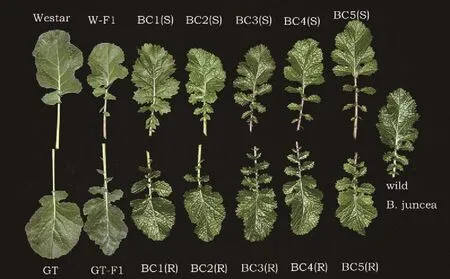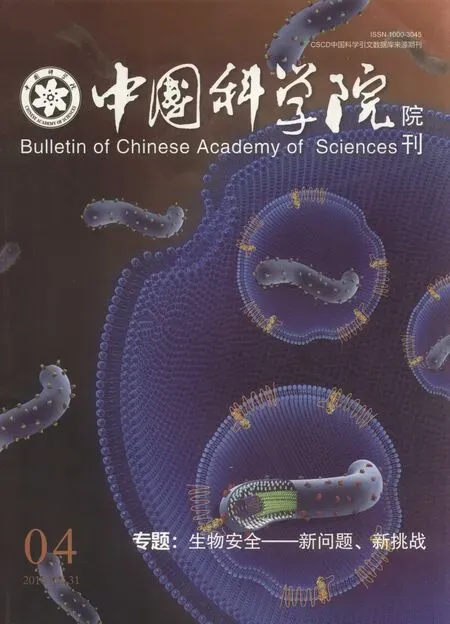转基因与生物安全*
魏 伟 马克平中国科学院植物研究所 植被与环境变化国家重点实验室 北京 100093
转基因与生物安全*
魏 伟 马克平
中国科学院植物研究所 植被与环境变化国家重点实验室 北京 100093

摘要文章以转基因作物为例讨论了转基因的生物安全。转基因作物在带来经济利益的同时,其对环境和健康的安全性也成为研究的焦点。从目前转基因生物安全主要争论的内容出发,包括转基因逃逸及其生态学后果、对非靶标生物影响、害虫的抗性进化等方面,结合相关的案例综合介绍了近年来的主要进展和存在的问题。对那些科技界争论较多,引起强烈社会反响事件的起因和主要结论进行了客观的评述,以期为进一步的科学研究提供依据。根据中国的实际情况,考虑到生物安全的要求,为保护生物多样性的可持续利用,提出相关的建议和对策:(1)以生物安全相关的科学问题为主,具体的目标生物为辅,开展系统的实验研究;(2)加强生物安全的监测与监管,鉴别重要生态功能区和生态脆弱区,适当设立转基因保护区,禁止种植转基因作物;(3)重视公众知情权,不仅宣传转基因生物带来的惠益,也应告知其风险及管控措施,促进公众的理解和认可。
关键词生物安全,生态风险,非靶标生物,抗性进化,转基因逃逸
DOI 10.16418/j.issn.1000-3045.2016.04.004
*资助项目:环保公益性行业科研专项(201509044)
修改稿收到日期:2016年2 月29日
转基因技术在转基因作物的商业化生产上取得了巨大成功,转基因作物的种植面积逐年扩大。转基因植物的大规模应用在为研发公司创造了不凡价值的同时,也为农民带来了可观的经济利益[1]。例如有研究认为,转基因抗除草剂作物的种植为种植户带来了不少利益,降低了除草剂的用量,也因为免耕对环境有一定的友好性,能够创造一定的环境效益[2]。然而事实却并非如此,Bonny[3]发现,随着草甘膦除草剂抗性的转基因植物大规模种植,全球范围内草甘膦除草剂的的用量大幅增加,在美国,大豆(Glycine max)上使用的除草剂总量和单位面积施用量自转基因抗除草剂大豆释放以来不断增加,而棉花(Gossypium hirsutum)和玉米(Zea mays)上单位面积上草甘膦使用量也是不断增加的[4]。由于持续和大量的单一除草剂施用,有多种杂草已经进化出对草甘膦除草剂的抗性[5]。
可以看出,转基因作物的大面积商业化生产确实能够为生产者和开发者带来丰厚的利益和利润,但是目前尚无任何能够增加产量和提高质量的转基因作物,为消费者带来的可能只是廉价的商品。转基因生物的安全性尚需要科学研究的证明,面对其带来的环境和健康风险,需要认真分析,审时度势,在风险评价中采取预先防范原则,以安全性为首要选项,尽量避免不得不面对“两害相权取其轻”的情况出现,采取有效的措施,在充分发挥转基因生物技术作用的同时,妥善管理和防范安全风险,保证生物安全。
对于转基因生物技术安全性的研究,可追溯至 20 世纪 80 年代重组 DNA 技术的发展之初。可以说国际上关于生物安全的研究和争论一直伴随着转基因生物技术的发展,经过多年的实验和实践,有一些在该技术发展之初就担心出现的风险,到今天已经变成了事实。例如由于大规模种植抗虫棉,棉铃虫(Helicoverpa armigera)种群被抑制,但其空余出来的生态位被非靶标害虫——盲椿蟓(Heteroptera: Miridae)侵占[6],田间的杀虫剂用药量也在增加[7]。在转基因作物释放的早期就有很多研究者对此发出了警告[8]。
如今,在中国,转基因抗虫棉的种植面积比例已经超过 90%[1],传统的棉花已经很少见。很多复合抗性和多价抗性转基因作物也在研发之中,这些多价转基因品种的生物安全评价将面临缺少非转基因对照的窘况,很可能不得不采用单价转基因或其他类型的植物做参考。随着气候变迁、环境变化,转基因作物的释放环境将可能有巨大变动,也就是说存在一定的不确定性,这也可能为安全评价和管理带来挑战。因此,需要及时回顾转基因作物在应用中已经发生的风险,为预知未来的风险提供理论和实践借鉴,避免转基因生物的利用带来不利的生物安全问题。
1 转基因逃逸及其影响
转基因作物与非转基因作物或其近缘种的基因交流能够造成转基因在自然界中的扩散和逃逸。转基因作物在收获后其种子散落田间地头,形成转基因土壤种子库[9],在随后的生长季节萌发生长,形成自播植物。据报道,由于长期种植转基因抗除草剂油菜(Brassica napus),抗性的油菜自播植物成为难以控制的田间杂草,尤其是在转基因抗除草剂的大豆和玉米田间[10]。转基因作物收获后,大量种子在运输过程中散落,可形成自播植物[11],成为转基因进一步扩散的来源。
通过花粉的传播,转基因作物可以污染其他同种的非转基因作物,造成一定的经济损失。例如,墨西哥政府于 2001年报告说 Oaxaca 州的玉米受到一种没有被批准在墨西哥种植的转基因 Bt 玉米的污染[12]。随后,Nature发表了墨西哥玉米受到转基因污染的分子证据[13]。然而,在有关压力下 Nature 撤回了文章。科学家对 2001 年的样品进行了重新分析,并在 2004 年重新取样进行检测,给出了地方品种受污染的新证据[14]。Worthy 等人[15]认为,由于发表研究结果而受到威胁,是生物技术公司及转基因技术的支持者不遗余力地维护其自身利益的表现,这也是我们在科学研究和管理中应该竭力避免的。
转基因作物与其野生亲缘种之间的杂交种是转基因作物与其野生亲缘种间基因流动的证据。杂交种和转基因在自然界中的生存适应能力的大小差异,可能会引起转基因在自然界中的进一步扩散。Warwick 等人[16]在加拿大抗除草剂油菜田附近收集其野生亲缘种——野生芜菁(B. rapa),发现了一株具有抗性的野生芜菁,其染色体倍性与野生亲本完全一致,为二倍体,且其后代有抗性和敏感个体的分离,抗性个体也是二倍体。预示着抗除草剂的外源基因已经在野生种群中整合和固定,这种固定在生态学上有重要意义。
中国是大豆、水稻和油菜这三种作物的起源中心,在野外存在着野生近缘植物。野生大豆是大豆的野生近缘种,是重要的育种资源。国内栽培大豆与野生大豆间的基因交流已有报道,半野生大豆的出现可能就是这种基因交流的结果[17]。携带外源转基因的大豆大面积释放,可能会导致外源基因对野生大豆资源的污染和危害[18]。已有研究证明,转基因水稻和油菜与其野生近缘种能在自然条件下发生基因交流[19,20],并且转基因在杂交种中的存在并不一定带来适合度代价[21-23];而在某些条件下,转基因在杂回交后代的表达还能提高植物的适合度[24,25]。Cao 等人[26]研究发现,转基因抗虫油菜与野生芥菜(B. juncea)的杂回交后代中转基因能够正常表达,具有跟转基因油菜亲本同样的杀虫活性,而且其形态也逐渐接近野生亲本(图 1),不易与野生亲本区分,转基因与其野生近缘种间杂交种的命运需要长期的监测研究。

图 1 栽培油菜(最左第1列,Westar和GT)与野生芥菜(wild Brassica juncea,最右)的杂交种(F1)和回交后代(BC1—BC5)的叶片形状逐步趋向其母本野生芥菜。Westar:非转基因油菜亲本品种;GT:转基因油菜;W-F1:非转基因亲本Westar与野生芥菜的杂交种; GT-F1:转基因油菜与野生芥菜的杂交种;S:不携带转基因的回交后代(不抗虫);R:携带转基因的回交后代(抗虫)
可以通过一些手段来阻断转基因的逃逸与扩散,例如通过物理隔离阻断转基因花粉的扩散。然而,花粉的扩散距离与转基因作物的种植面积有关,而当传粉昆虫参与到花粉传播中时,其距离能够达到 1—2 公里[27,28]。通常,玉米和水稻被认为是风媒植物,但研究表明虫媒在水稻和玉米花粉传播中也起到一定的作用[29,30]。有研究认为也可以调整种植时间,使转基因作物与周围的植物花期不遇,从而避免基因交流。但是绝对的花期不遇无法做到,过分强调花期不遇则可能会影响到作物本身的产量。在分子水平上有一些阻断基因流的建议和应用[31],例如将转基因插入叶绿体基因组和使用雄性不育的品系,然而 Ford 等人[32]通过分析栽培油菜野生近缘种芜菁种群的叶绿体基因组,认为使用叶绿体转基因技术或雄性不育技术只能将基因流降低 77%—98.5%,并不能保证完全阻断转基因的扩散。因此,目前在技术上还难以阻断转基因通过基因流扩散的途径[31]。
2 对非靶标生物的影响
转基因作物释放到环境中以后,会与环境中的其他生物发生相互作用。在这方面一个很著名的例子就是转基因 Bt 玉米花粉对黑脉金斑蝶(Danaus plexippus)幼虫的致死作用[33]。Nature 的这篇报道一经发表,引起了科技界的震动,为了验证这个结果,很多研究者开展了相关研究。根据研究结果,Bt 玉米花粉对黑脉金斑蝶幼虫的不利影响取决于玉米花粉中 Bt 蛋白含量和田间马利筋(Asclepias curassavica)植物叶片上的花粉密度。研究表明,当时只有个别的转基因材料(如已被淘汰的 Novatis 公司 176Bt 玉米)花粉中 Bt 蛋白的含量足以杀死蝴蝶幼虫[34-36],而其他单价 Bt 玉米材料(如 Mon810 和 Bt-11)花粉中 Bt 蛋白的含量可能不足以对蝴蝶幼虫产生影响。但是,表达六种 Bt蛋白的多价抗虫玉米品种(SmartStax)花粉中 Bt 蛋白的含量大约为 200 ug/g 干重,足以杀死蝴蝶幼虫[37]。而且,黑脉金斑蝶毕竟是鳞翅目的昆虫,低量的 Bt 蛋白至少会对幼虫产生潜在的亚致死或长期影响[37]。
Rosi-Marshall 等人[38]发现转基因玉米地附近的河流会把玉米的花粉、叶片或残枝带进农田水系,对水生生物如石蛾(Lepidostoma liba)产生不利影响。该研究也引起巨大反响,批评者认为由于 Rosi-Marshall 等人的研究没有合适的非转基因对照,很可能是玉米不同品种的成分含量不同导致对水生昆虫的不利影响。但是,研究人员于 2010 年再次报道了 Bt 玉米对水生昆虫石蛾的不利影响[39],认为在人工干扰比较大的退化农田生态系统中,由于干扰因素多,有时在实验室检测到的单一的 Bt 蛋白影响的差异在野外不一定能检测到。研究者也在河流中检测到 Bt 蛋白的存在(平均为 14 ng/L,最高达 32 ng/L)[40]。转基因材料扩散到农田水系的途径是清晰的,其可能产生的生态学影响需要深入的研究。另外植食性昆虫取食转基因材料后,其体内就会有转基因产物的残留,而昆虫天敌再捕食(图 2)或寄生这样的昆虫后,昆虫天敌的生长发育也有可能受到影响[41]。

图 2 草蛉(Chrysopa sinica)幼虫正在捕食棉铃虫幼虫
转基因作物对小型哺乳动物的影响是目前研究关注的另一焦点,而研究者对研究结果的解释决定着转基因作物是否有不利影响的结论。Séralini 等人[42]研究发现,转基因玉米更易导致大鼠患肿瘤死亡,许多人对这一研究提出了质疑,认为该研究的样本量太小且没有做统计学分析。但与以往的转基因安全研究相比,该研究在时间上持续了 2 年,是前所未有的;并且,该研究在转基因组与非转基因组的同时,还添加了除草剂组,这是非常科学的。虽然备受争议,但该研究无疑是有科学意义的,至少提出了科学问题和研究方向。该 2012 年发表的论文被原发刊物撤稿,但在 2014 年又得以重新发表[42],证明其研究是得到科技界认可的。Rubio-Infante 和 Moreno-Fierros[43]认为转基因作物对小型哺乳动物的影响要参考对化学农药的评价标准,使用至少3种不同的实验动物,进行最短两年的动物实验。
3 害虫的抗性进化
转基因 Bt 作物的大面积释放可能会加速害虫对 Bt 蛋白的抗性进化[44]。Bt 蛋白在害虫上中肠受体的任何突变都可能导致害虫的抗性进化。有研究发现,害虫的抗性基因并非像我们通常认为的都是隐性的,显性抗性也是存在的[45]。一般来讲,避难所策略成功的一个前提是假设害虫的抗性是隐性的,显性抗性使害虫进化机制变得复杂,从而导致了害虫进化治理的困难。
近年来,携带多个叠加 Bt 抗性基因作物出现的主要原因正是为了应对害虫对 Bt 作物的耐受性进化的结果[46]。但其应对害虫抗性进化的效果却不显著,Carrière 等人[47]认为其原因是目前使用的 Bt 蛋白由于具有相似的序列,有很高概率的交叉抗性出现。中国在大规模释放 Bt 抗虫棉的不到 8 年时间,就已经有报道害虫抗性进化的案例[48]。然而,由于棉铃虫在中国多样化的小农生产中,除棉花外,具有多个摄食对象,如玉米、大豆和蔬菜等,这些作物能够作为“天然避难所”,为敏感的棉铃虫种群提供食物,敏感昆虫种群的存在能够降低田间的抗性频率,因此中国棉铃虫对 Bt 蛋白的抗性进化还局限在部分地区[49],并没有导致棉田 Bt 棉失去对棉铃虫的控制[50]。然而,与种植非转基因棉花作为避难所相比,利用“天然避难所”策略在延缓抗性方面的效率还是比较低的[51]。而且,与杂食性的棉铃虫形成鲜明对比,生长在南方长江流域的红蛉虫(Pectinophora gossypiella)则由于专食棉花,而又没有“天然避难所”的存在,其抗性进化较明显[52]。在印度,田间抗性红铃虫种群的抗性能达到敏感种群的 40 多倍[53]。转基因抗虫棉本身并不能实现害虫的长期有效控制,还需要结合其他综合治理措施(如作物轮作、生防、传统抗性作物品种以及合适的杀虫剂喷施等)才能促进可持续农业的发展[54]。
4 讨论与建议
4.1超越化学防治,注重转基因技术的可持续利用
为了应对靶标害虫对单价转基因 Bt 作物的抗性进化,生物技术专家又去开发携带若干个 Bt 杀虫基因的叠加抗性材料。由于存在协同作用和交叉抗性,所以同时表达多种 Bt 蛋白转基因植物的杀虫效果却不理想[47]。转基因抗除草剂作物的大面积种植导致施用除草剂比较单一,当越来越多的田间杂草进化出对某一种除草剂的抗性时,科学家不得不去添加另外一种抗除草剂基因。例如有的生物技术开发公司会添加 2,4-D 抗性基因,开发所谓的下一代抗除草剂作物。然而由于非靶标效应比较大,陶氏益农公司的复合除草剂 Enlist Duo(含草甘膦和 2,4-D)刚刚上市一年,便被美国环保局取消了安全证书[55]。说明目前主要的转基因技术仍然停留在化学防治的老路上,很难达成可持续发展的目标。实际上,简单地只使用除草剂控制杂草的路会越来越窄,并有可能人为地加速杂草的抗性进化[5]。
4.2传统育种与现代生物技术相结合,促进农业的可持续发展
转基因技术作为现代生物技术的重要组成,需要得到不断的完善和提升,但其大规模应用须谨慎。近年来在大力推动转基因技术育种的同时,相对地忽视了传统育种和其他生物技术的应用,一定程度上挫伤了传统育种工作者的积极性。2016 年启动的“十三五”国家重点发展计划“七大农作物育种试点专项”种质资源与育种创新共举,将会促进传统育种工作的开展。在生物安全方面,传统育种的安全性在公众意识里具有不可否认的安全认同感,寄希望该试点专项能够在利用现代分子生物学和现代组学技术的同时,充分重视并推动传统育种技术的进步,为农业的可持续发展和生物多样性的可持续利用作出贡献。
4.3加强进口产品中转基因成分的管理,降低生物安全风险
全球转基因作物的栽种面积连年增长,据报道,发展中国家栽培的转基因作物已经连续3年超过发达国家。然而,除中国以外,其他发展中国家种植的转基因作物大都来自发达国家的生物技术公司,很少有发展中国家自行研制和开发的产品。大豆、玉米和油菜 2014 年全球转基因比例分别为 82%、30% 和 25%,而且最近几年一直维持这样一个水平[1]。但中国每年进口的用于加工的大豆、玉米和油菜的转基因比例均高于 90%[1,56],其原因是中国进口原材料的来源地主要是一些大面积种植转基因材料的国家,如美国、巴西和阿根廷等[57]。可能的解释是这些地区的产品有质量优势或价格优势,或二者兼有,但实际情况需要深入的研究才能有结论。一般来讲,大规模种植某类产品前都需要进口国的批准才能保证销路,我们也不妨考虑借助这样的方式,积极鼓励和引导这些地区的农户种植非转基因产品,或者转向非转基因材料或在转基因比例较低的其他种植地区采购,保护我国农业(如大豆)的健康发展和生物安全。
4.4建立转基因生物禁止释放区,保护重要生态区域的生物多样性
中国是水稻和大豆的起源中心,野外也存在油菜等芸苔属栽培作物(Brassica spp.)的野生近缘种,水稻、大豆和油菜等作物与其野生近缘种间存在基因流动,而且在将来大规模种植转基因作物的情况下,其杂交后代有可能并不会因为携带外源转基因而降低适合度,可以长期在自然界中留存和进化,对生物多样性造成不利影响。同时,考虑到转基因植物种植带来的害虫和杂草的抗性进化、除草剂的大量使用以及对非靶标生物可能存在的影响,为保证环境安全,亟需在时间和空间上分析风险,鉴别需要充分保护的和脆弱的重要生态区域,考虑的对象包括自然保护区和生物多样性保护优先区域等,设立禁止种植转基因植物的地区。
4.5关注公众知情权,并以科学问题为导向开展转基因生物安全研究
公众知情权是技术发展的重要支柱,有利于公众用科学的态度对待转基因产品。公众只有同时了解其优势和可能的风险,才能以更加开放的态度对待转基因产品。无论是开发主粮还是非主粮转基因作物,都离不开农业生产过程,都需要释放到环境中去,其生态学风险与后果需要根据预先防范原则谨慎评价。目前主要是按照目标对象进行评价的形式,对生产应用来说是比较高效的,但对科学研究而言却不一定合适。亟需针对转基因生物及其相关科学问题,建立模式研究体系;针对相关风险类型,展开长期的系统研究,建立风险监测框架,更好地为科学进步、环境健康和农业可持续发展服务。
参考文献
1 James C. Global Status of Commercialized Biotech/GM Crops: 2014. ISAAA Brief No. 49. Ithaca, NY: ISAAA, 2014.
2 Brookes G, Peter Barfoot P. Key environmental impacts of global genetically modified (GM) crop use 1996-2011. GM Crops & Food, 2013, 4:109-119.
3 Bonny S. Genetically modified herbicide-tolerant crops, weeds, and herbicides: overview and impact. Environmental Management, 2016. 57; 31-48.
4 Coupea R H, Capel P D. Trends in pesticide use on soybean, corn and cotton since the introduction of major genetically modified crops in the United States. Pest Management Science, 2015. DOI: 10.1002/ps.4082 .
5 Glibert N. A hard look at GM crops. Nature, 2013, 497: 24-26.
6 Lu Y, Wu K, Jiang Y, et al. Mirid bug out breaks in multiple crops correlated with wide-scale adoption of Bt cotton in China. Science, 2010, 328: 1151-1154.
7 Qui J. GM crop use makes minor pests major problem.Pesticide use rising as Chinese farmers fight insects thriving on transgenic crop. Nature News, 2010. DOI: 10.1038/news.2010.242.
8 钱迎倩, 魏伟, 桑卫国, 等. 转基因作物对生物多样性的影响.生态学报, 2001, 21: 337-343.
9 Zhu Y M, Li Y D, Colbach N, et al. Seed losses at harvest and seed persistence of oilseed rape (Brassica napus) in different cultural conditions in Chinese farming systems. Weed Research, 2012, 52: 317-326.
10 Leeson J. Residual weed population shifts in Saskatchewan-1976 to 2015. 69th Annual Meeting of the Canadian Weed Science Society. Edmonton, AB, Canada, 2015.
11 Yoshimura Y, Beckie H J, Matsuo K. Transgenic oilseed rape along transportation routes and port of Vancouver in western Canada. Environmental Biosafety Research, 2006, 5 (2): 67-75.
12 Dalton R. Transgenic corn found growing in Mexico. Nature, 2001, 413: 337.
13 Quist D, Chapela I H. Transgenic DNA introgressed into traditional maize landraces in Oaxaca, Mexico. Nature, 2001, 414: 541-543.
14 Piñeyro-nelson A, van Heerwaarden J, Perales H R, et al. Transgenes in Mexican maize: molecular evidence and methodological considerations for GMO detection in landrace populations. Molecular Ecology, 2009, 18: 750-761.
15 Worthy K, Strohman R C, Paul R, et al. Conflicts around a study of Mexican crops. Nature, 2002, 417: 897.
16 Warwick S I, Légère A, Simard M J, et al. Do escaped transgenes persist in nature? The case of a herbicide resistance transgene in a weed population of Brassica rapa. Molecular Ecology, 2008, 17: 1387-1395.
17 Wang K J, Li X H, Zhang J J, et al. Natural introgression from cultivated soybean (Glycine max) into wild soybean (Glycine soja) with the implications for origin of populations of semiwild type and for biosafety of wild species in China. Genetic Resources and Crop Evolution, 2010, 57: 747-761.
18 赵波, 张鹏飞. 抗除草剂转基因大豆的生态安全评价进展.山地农业生物学报, 2012, 31: 70-76.
19 Chen L J, Lee D S, Song Z P, et al. Gene flow from cultivated rice (Oryza sativa) to its weedy and wild relatives. Annals of Botany, 2004, 93: 67-73.
20 Jørgensen R B, Andersen B. Spontaneous hybridization between oilseed rape (Brassica napus) and weedy B. campestris (Brassicaceae): a risk of growing genetically modified oilseed rape. American Journal of Botany, 1994, 81(12): 1620-1626.
21 Di K, Stewart C N Jr, Wei W, et al. Fitness and maternal effects in hybrids formed between transgenic oilseed rape (Brassica napus L.) and wild brown mustard [B. juncea (L.) Czern et Coss.] in the field. Pest Management Science, 2009, 65: 753-760.
22 Yang X, Wang F, Su J, et al. Limited fitness advantages of cropweed hybrid progeny containing insect-resistant transgenes (Bt/ CpTI) in transgenic rice field. Plos One, 2012, 7: e41220.
23 Guan Z J, Zhang P F, Wei W, et al. Performance of hybrid progeny formed between genetically modified herbicide-tolerant soybean and its wild ancestor. AoB Plants, 2015, 7: plv121.
24 Wang W, Xia H, Yang X, et al. A novel 5-enolpyruvoylshikimate-3phosphate (EPSP) synthase transgene for glyphosate resistance stimulates growth and fecundity in weedy rice (Oryza sativa) without herbicide. New Phytologist, 2014, 202: 679-688.
25 Liu Y B, Darmency H, Stewart C N Jr, et al. The effect of Bttransgene introgression on plant growth and reproduction in wild Brassica juncea. Transgenic Research, 2015, 24: 537-547.
26 Cao D, Stewart C N Jr, Zheng M, et al. Stable Bacillus thuringiensis transgene introgression from Brassica napus to wild mustard B. juncea. Plant Science, 2014, 227: 45-50.
27 Rieger M A, Lamond M, PrestonC, et al. Pollen-mediated movement of herbicide resistance between commercial canola fields. Science, 2002, 296: 2386-2388.
28 Hofmann F, Otto M, Wosniok W. Maize pollen deposition in relation to distance from the nearest pollen source under common cultivation-results of 10 years of monitoring (2001 to 2010). Environmental Sciences Europe, 2014, 26: 24.
29 Emberlin J. A report on the dispersal of maize pollen. [2016-3-10]. http://www.mindfully.org/GE/Dispersal-Maize-Pollen-UK. htm.
30 Pu D Q, Shi M, Wu Q, et al. Flower-visiting insects and their potential impact on transgene flow in rice. Journal of Applied Ecology, 2014, 51: 1357-1365.
31 Gressel J. Dealing with transgene flow of crop protection traits from crops to their relatives. Pest Management Science, 2015, 71: 658-667.
32 Ford C S , Allainguillaume J, Fu T Y R, et al. Assessing the value of imperfect biocontainment nationally: rapeseed in the United Kingdom as an exemplar. New Phytologist, 2015, 205: 1342-1349.
33 Losey J E, Rayor L S, Carter M E. Transgenic pollen harms monarch larvae. Nature, 1999, 399: 214.
34 Hellmich R L, Siegfried B D, Sears M K, et al. Monarch larvae sensitivity to Bacillus thuringiensis-purified proteins and pollen. PNAS, 2001, 98: 11925-11930.
35 Stanley-Horn D E, Dively G P, Hellmich R L, et al. Assessing the impact of Cry1Ab-expressing corn pollen on monarch butterfly larvae in field studies. PNAS, 2001, 98: 11931-11936.
36 Zangerl A R, McKenna D, Wraight C L, et al. Effects of exposure to event 176 Bacillus thuringiensis corn pollen on monarch and black swallowtail caterpillars under field conditions. PNAS, 2001, 98: 11908-11912.
37 Hilbeck A, Otto M. Specificity and combinatorial effects of Bacillus thuringiensis Cry toxins in the context of GMO environmental risk assessment. Frontiers in Environmental Science, 2015, 3:71.
38 Rosi-Marshall E J, Tank L, Royer T V, et al. Toxins in transgenic crop by products may affect head water stream ecosystems. PNAS, 2007, 104: 16204-16208.
39 Chambers C P, Whiles M R, Rosi-marshall E J, et al. Responses of stream macroinvertebrates to Bt maize leaf detritus. Ecological Applications, 2010, 20: 1949-1960.
40 Tank J L, Rosi-Marshall E J, Royer T V. Occurrence of maize detritus and a transgenic insecticidal protein (Cry1Ab) within the stream network of an agricultural landscape. PNAS, 2010, 107: 17645-17650.
41 魏伟, 关正君, 马克平. 转基因作物的生态风险评价研究进展//新生物学年鉴 2015. 北京: 科学出版社, 2016: 137-163.
42 Séralini G-E, Clair E, Mesnage R, et al. Long term toxicity of a Roundup herbicide and a Roundup-tolerant genetically modified maize. Environmental Sciences Europe, 2014, 26:14.
43 Rubio-Infante N, Moreno-Fierros L. An overview of the safety and biological effects of Bacillus thuringiensis Cry toxins in mammals. Journal of Applied Toxicology, 2015, DOI: 10.1002/ jat. 3252
44 魏伟,钱迎倩,马克平. 害虫对转基因作物的抗性及其管理对策. 应用与环境生物学报,1999, 5: 215-228.
45 Campagne P, Kruger M, Pasquet R, et al. Dominant inheritance of field-evolved resistance to Bt Corn in Busseola fusca. Plos One, 2013, 8 (7): e69675.
46 Tabashnik B E, Brevault T, Carriere Y. Insect resistance to Bt crops: lessons from the first billion acres. Nature Biotechnology, 2013, 31: 510-521.
47 Carriere Y, Crickmore N, Tabashnik B E. Optimizing pyramided transgenic Bt crops for sustainable pest management. Nature Biotechnology, 2015, 33: 161-168.
48 Li G P, Wu K M, Gould F, et al. Increasing tolerance to Cry1Ac cotton from cotton bollworm was confirmed in Bt cotton farming area of China. Ecological Entomology, 2007, 32: 366-375.
49 An J J, Gao Y L, Lei C L, et al. Monitoring cotton bollworm resistance to Cry1Ac in two counties of northern China during 2009–2013. Pest Management Science, 2015, 71: 377-382.
50 Zhang H, Yin W, Zhao J, et al. Early warning of cotton bollworm resistance associated with intensive planting of Bt cotton in China. Plos One, 2011, 6: e22874.
51 Jin L, Zhang H N, Lu Y H, et al. Large-scale test of the natural refuge strategy for delaying insect resistance to transgenic Bt crops. Nature Biotechnology, 2015, 33: 169-174.
52 Wan P, Huang Y X, Wu H H, et al. Increased frequency of pink bollworm resistance to Bt toxin Cry1Ac in China. Plos One, 2012, 7: 29975.
53 Dhurua S, Gujar G T. Field-evolved resistance to Bt toxin Cry1Ac in the pink bollworm, Pectinophora gossypiella (Saunders) (Lepidoptera: Gelechiidae), from India. Pest Management Science, 2011, 67: 898-903.
54 Gao Y L, Liu C X, Wu Y D, et al. Status of resistance to Bt Status of resistance to Bt cotton in China: cotton bollworm and pink bollworm. CrossRef. in: M. Soberón, (Ed.) Bt Resistance: Characterization and Strategies for GM Crops Producing Bacillus thuringiensis Toxins. Oxfordshire: CABI Press, 2015: 15-25.
55 Achitoff P, Kimbrell A, Burd LA, Towers P. EPA revokes approval of Dow’s “Enlist Duo” herbicide because of high toxicity. [2016-3-10]. http://www.biologicaldiversity.org/news/ press_releases/2015/enlist-duo-11-25-2015.html.
56 李想, 潘良文, 李俊毅, 等. 进口油菜籽中不同转基因品系的检测与分析. 中国油料作物学报, 2011, 33 (1): 77-82.
57 Anderson-Sprecher A, Ma J. China -Agricultural Biotechnology Annual. Global Agricultural Information Network Report No. 14032. USDA Foreign Agricultural Service, 2014-12-31.
魏 伟 中科院植物所副研究员,博士,多年来一直从事转基因生物安全和生物多样性保护的研究工作。主持和参与多项自然科学基金项目和国际合作项目,发表 SCI 论文 35 篇。目前担任中国农业生物技术学会生物安全分会副秘书长、联合国《生物多样性公约》风险评价与风险管理特设技术专家组专家。E-mail: weiwei@ibcas.ac.cn
Wei Wei Received his Ph.D. degree from the Institute of Botany, Chinese Academy of Sciences. He has worked on biosafety of transgenic technology and biodiversity conservation for more than 15 years and has published 35 paper in Science Citation Indexed journals. He now acts as a Vice Secretary of the Biosafety Association of the China Agro-Biotechnology Society and an expert member of the Ad Hoc Technical Expert Group on Risk Assessment and Risk Management of the Convention on Biological Diversity of the United Nations. E-mail: weiwei@ ibcas.ac.cn
Transgenic Organisms and Biosafety
Wei Wei Ma Keping
(State Key Laboratory of Vegetation and Environmental Change, Institute of Botany, Chinese Academy of Sciences, Beijing 100093, China)
AbstractBiosafety issues of transgenic organisms were discussed in this review using transgenic crops as examples. The global commercialization of transgenic crops has produced benefits but also accompanies potential risks. The four most popular transgenic crops that commercially planted in the past years are soybean(Glycine max), cotton(Gossypium hirsutum), corn(Zea mays), and canola(Brassicabook=413,ebook=33napus). The current modified traits that have the largest area at worldwide scale are herbicide resistant, insect resistant, and their stacked traits of both resistance. All those traits may confer advantage in the field. At the early stage of transgenic technology application, its risks had been raised as issues for discussion by both scientists and general public, which is the critical component under consideration for associated research. With the development and application of this technology, its risks to human health and environmental safety have been hot topics for debating. Some risk concerns had become hazards in real, such as the outbreak of secondary insect pests, the resistance evolution of some targeted insect pests and some non-targeted weeds, and the effects on non-targeted organisms etc. Among them, the effects on non-target organism have been the most complicate issue in debate. Those issues and related events that had caused extensive debate and profound social impacts were reviewed in this article to set up important base for further discussion. The cause behind the debate was analyzed and the final conclusive result of debated issues was then provided. It has been a common phenomenon that there are always contradictive opinions on the same revealed effects of transgenic crops between advocators or developer of the transgenic technology and opponents or environmentalists. For example, when the evidence of contamination of Mexico maize landraces was firstly published, the publication had received many criticisms and had even been retracted by the journal. Finally, nobody would question again on the contamination fact when more evidences came out years later. Conversely, it was reported that the maize pollens expression Bt(Bacillus thuringiensis)insecticidal protein could kill the larvae of monarchy butterfly(Danaus plexippus). But further studies had revealed that the concentration of the Bt in the pollens and pollen density on the leaves of Asclepias curassavica were not able to kill the larvae except transgenic events that expressing higher concentration of Bt protein in pollens. Nonetheless, butterfly is belonged to the order of Lepidoptera that is susceptible to the popular Bt protein used in currently commercialized crops and sublethal and long term impact should not be neglected. Anyway, safety is always the first priority in the application of transgenic technology. To ensure the sustainable use of biodiversity and biosafety of environment, strategies were proposed in this review to provide references for further investigation:(1)Biosafety studies and risk assessments shall be based on scientific questions other than targeted transgenic organisms and the latter can be only relevant when complementary to the issue questioned.(2)Enforcing the general surveillance and monitoring regarding of the potential risks of transgenic crops, protected locations such as important ecological functional areas and vulnerable ecological regions shall be identified to be prohibited from planting of transgenic crops.(3)To enhance the public awareness by providing not only the benefits of the transgenic technology, but also the risks and related management strategies to the public. Only in this way, the understanding and acceptance of this technology can be achieved and the biosafety and development will be promoted. In addition, promotion of conventional breeding and possibility to import products from regions with low adoption of transgenic technology or opportunity to encourage the plantation of non-transgenic crops in exporting countries also been briefly suggested.
Keywordsbiosafety, ecological risk, non-targeted organisms, resistance evolution, transgene escape

